Mothra vs. King Ghidorah: Which Toho Monster Will Appear in the Next U.S. Godzilla Movie?
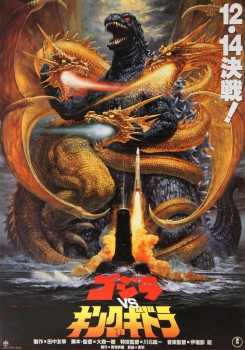
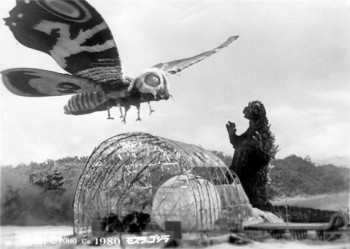 Caution: This article discusses some details about Godzilla ‘14 that viewers who have yet to see the film may consider spoilers. (Non-spoiler review here.) Viewers who haven’t seen the film should also go take care of that now.
Caution: This article discusses some details about Godzilla ‘14 that viewers who have yet to see the film may consider spoilers. (Non-spoiler review here.) Viewers who haven’t seen the film should also go take care of that now.
Legendary Pictures and Warner Bros. felt confident enough about the almost $200 million that the new Godzilla took in at the global box office during its opening weekend — the biggest International opening of 2014 at that point — to announce a few days later what everyone knew the moment the movie started pulling in heaps of cash: “Yep, we’re gonna make another one.”
We know little more at the moment. In the build up to Godzilla ‘14, all parties involved avoided sequel speculation. Director Gareth Edwards — whose association in a follow-up is uncertain at this time, especially since he signed on to direct the first Star Wars spin-off movie — made brief mention of doing something with the “Monster Island” concept introduced in Destroy All Monsters (1968), but nothing specific. Which means we can all speculate freely and wildly about what might happen in Godzilla Raids Again or whatever title “Godzilla II” has.
The big question about any Godzilla sequel: What other monster(s) will appear? Although it’s possible for Legendary Pictures to go with an original creature — and they did well with the MUTOs — it’s almost a guarantee they’ll negotiate with Toho Studios for the rights to one of the classic kaiju. Toho is reportedly through the roof with excitement over the new movie, so the negotiations won’t be aggressive.
There are many monster possibilities, but most online speculation has landed on two superstars: Mothra and King Ghidorah. Any Godzilla fan would place these kaiju at the top of a list of “must haves.”
To the objection that Mothra and King Ghidorah are too outlandish for a “realistic” take on Godzilla, I want to point out that the new G-film feels like an open world that isn’t going to remain realistic much longer. The movie is willing to embrace classic Godzilla ideas to the point that bringing in almost any monster isn’t out of the question. Max Borenstein, the screenwriter of Godzilla ‘14, has made the point that this “realism” allows almost anything: “The same way Chris Nolan was so brilliantly able to create a Joker that felt of a piece in his dark and grounded reality, whereas if you just watched the television series from the ’60s, the Batman shows, you would have said that was impossible. I think it’s possible.”
The “possible” creature he was specifically referencing? Mothra.
With the gates thrown open like this, I’ll engage in my own speculation based on Mothra’s and King Ghidorah’s histories and the current Godzilla film and its setting to see how either monster might work.
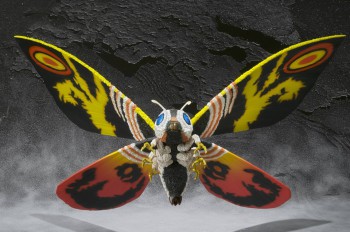 Mothra (Mosura)
Mothra (Mosura)
After Godzilla, this moth-god is the most popular giant monster in Japan. Mothra debuted in an eponymous 1961 film that is a watershed moment not only for the Japanese giant monster genre, but for Japanese fantasy and science-fiction films in general. It marked the point where what had started as a Japanese take on a U.S. genre peeled away into unique territory. Mothra was a giant monster, but also a mythic, spiritual creature and the movie around it was filled with color and scope different from the semi-documentary style of earlier Toho SF pictures. Mothra scored a huge hit and two years later, its star went up against Godzilla in arguably the best film of the G-series, Mothra vs. Godzilla (originally released in the U.S. as Godzilla vs. The Thing to make the identity of Godzilla’s opponent into a mystery gimmick).
Mothra’s filmography since those first two films is prodigious: Ghidorah, The Three-Headed Monster (1964), Ebirah, Horror of the Deep (1966), Destroy All Monsters (1968), Godzilla vs. Mothra (1992), Godzilla, Mothra, King Ghidorah: Giant Monsters All-Out Attack (2001), Godzilla: Tokyo S.O.S. (2003), Godzilla: Final Wars (2004), and a solo trilogy, Rebirth of Mothra I–III (1996–1998).
Mothra always appears in a positive light in its movies: the gentle giant — as long as you don’t kidnap its fairy priestesses — who represents the spirit of Earth in the face of other destructive monsters. No other Toho creature has been responsible for less destruction than Mothra. Mothra instead works as a conduit between humanity — with whom Mothra will willingly choose to work given the right circumstances — and the other monsters.
Mothra is the only Toho creature whom Godzilla ‘14 references. An early scene at the Janjira power plant contains a shot of a classroom, where a picture of a spread-winged moth with a similar color pattern to Mothra is positioned on the chalkboard in the center of the frame, impossible for the eye to miss. Later, when the two Brodys return to the ruins of their home in Janjira, the camera places a terrarium in the foreground with the word “Mothra” written on a piece of tape across it. A few shots show larva-like creatures crawling around the ruins of glass container.
An in-joke for fans? Or an actual set-up? It could be either. Here’s screenwriter Max Borenstein on the topic: “I can’t say the Mothra Easter Egg is an indication of any specific plans for Mothra, though everyone has a fondness — I know I speak for [director] Gareth [Edwards], and I speak for Legendary — everyone has a great fondness for all the Toho characters.”
So basically, “We aren’t going to tell you, but we think Mothra is cool!”
If we take the shots from these scenes as a direct set-up for the future, Mothra could arise from the radiation accident in Janjira that the male MUTO caused. But that’s an unnecessary step, since Mothra has an easy entrance into the story that works with the film’s mythology of primordial beasts that went into hiding approximately 250 million years ago. This comes from the tie-in prequel comic written by Borenstein and his brother, Godzilla: Awakening. The comic establishes that there was a great variety of MUTOs, with many unusual and often-alien seeming shapes, in pre-Mesozoic Earth. Mothra could be a type of “Queen” MUTO that reawakens, but one that no longer needs radiation to survive and had adapted to a peaceful existence on the new Earth… and then Godzilla seeks it out.
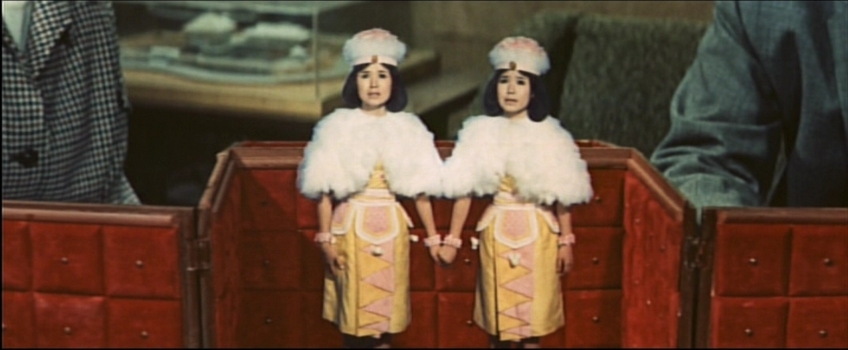 Any discussion of Mothra must address the Shobijin (“little beauties”), the twin miniature fairies who serve as Mothra’s priestesses in most incarnations. Mothra in the Showa Toho-verse comes from Infant Island, where the natives and the Shobijin worship the moth-god. The fairies are an important part of Mothra’s personality and motivations. Can the Shobijin work within the setting developed in Godzilla ‘14 and Godzilla: Awakening?
Any discussion of Mothra must address the Shobijin (“little beauties”), the twin miniature fairies who serve as Mothra’s priestesses in most incarnations. Mothra in the Showa Toho-verse comes from Infant Island, where the natives and the Shobijin worship the moth-god. The fairies are an important part of Mothra’s personality and motivations. Can the Shobijin work within the setting developed in Godzilla ‘14 and Godzilla: Awakening?
Yes, and in different ways. If Mothra emerges from hibernation, it’s easy to imagine a small island, perhaps one occupied during the War or one located near a nuclear test site, that worshipped the memory of Mothra from distant history when it stirred before. Putting telepathy into the story wouldn’t be a stretch; you can have two women on the island with telepathic powers to communicate to Mothra in its sleep. These women become the Shobijin and their powers pass down through generations as a priesthood — or perhaps the powers only manifest when twins are born. A story that deals with Mothra awakening, possibly in response to the events around the MUTOs and Godzilla, would have excellent dramatic potential as the Shobijin try to convince the world that Mothra means no harm. This idea was used well in 2003’s Godzilla: Tokyo S.O.S., a movie that offers excellent template ideas on how to tackle further Godzilla stories on screen.
Whether the Shobijin appear as standard-sized women or as the six-inch tall fairies of the Toho-verse is, I think, unimportant: what’s important is their relationship to Mothra and Mothra’s relationship to Earth and its people. There is a fantastic conflict about gentle nature vs. raw nature and a spiritual expansion of the environmental themes of Godzilla ‘14 implicit in bringing Mothra in as the next adversary.
Also, if I may make a casting suggestion: for the Shobijin, consider actress Rila Fukushima, who played Yokio in The Wolverine, to take both parts. Her childlike-look and strong screen presence (she stole The Wolverine from its ostensible female lead) make her perfect for the part.
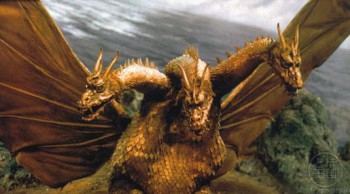 King Ghidorah (Kingu Ghidorah)
King Ghidorah (Kingu Ghidorah)
What the Joker is to Batman, King Ghidorah is to Godzilla, and that makes the towering golden three-headed space dragon a major consideration for everyone who makes The Dark Knight comparisons for the new Godzilla series. It almost seems like a no-brainer to include King Ghidorah — except Mothra also has a strong case in a “let’s put Superman in a team-up with Batman!” sort of way.
King Ghidorah first appeared in Ghidorah, The Three-Headed Monster in 1964, the follow-up to the smash success of Mothra vs. Godzilla earlier that year. This was the film that first established Godzilla in a heroic role, when the monster joined forces with Rodan and Mothra to fight against the alien invader. King Ghidorah came back to battle Godzilla three more times in the Showa Era: Invasion of Astro-Monster (1965), Destroy All Monsters (1968), and Godzilla vs. Gigan (1972).
Ghidorah returned in the Heisei series in Godzilla vs. King Ghidorah (1991), where it started as the villain, and then in the identity of Mecha-King Ghidorah, as a human-controlled weapon. The Millennium series gave King Ghidorah its only pure heroic role in Godzilla, Mothra, King Ghidorah: Giant Monsters All-Out Attack (2001), although it was much underpowered. A version of King Ghidorah called “Keizer Ghidorah” showed up in the finale of Godzilla: Final Wars (2004). To add a few more films to its roster, the three-headed dragon was featured in the first and third installments of the 1990s Mothra trilogy, appearing in the first under altered guise as “Death Ghidorah” (Desu Ghidorah).
The films have portrayed King Ghidorah, with a few exceptions, as an alien creature. In its original appearance, Ghidorah was a free agent, simply ravaging planets across the galaxy during many millennia. Later, Ghidorah came under control of various alien invaders, who used it as a tool. With the strange exception of Godzilla, Mothra, King Ghidorah: Giant Monsters All-Out Attack, King Ghidorah is unsympathetic and brings the Earth nothing but grief until the planet’s defenders step up to defeat it. King Ghidorah is about as true a nemesis as Godzilla has, and with an unforgettable design.
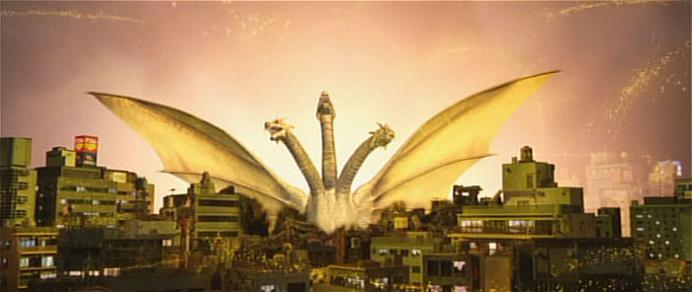 As a concept for the new movie series, Ghidorah has a good basis from its first film appearance, where it arrived on Earth via asteroid. I’ll attempt to tie this core concept into the mythology of the Legendary Godzilla-verse as we currently understand it. The MUTOs and the giant creatures similar to Godzilla (two different biological groups) existed 250 million years ago, and were unlike the other, smaller life forms of the period that died out at the end of the Permian. Could the MUTOs possibly have an extraterrestrial origin, as opposed to a terrestrial origin for Godzilla? Panspermia, the theory that life on Earth may have originated from the impact of extraterrestrial debris containing microbes, is a subject of serious scientific debate; the MUTOs could be an example of a life form with an off-planet beginning. Why not another off-planet visitor, closer to our day and age? King Ghidorah might come from an unearthed meteorite containing three separate creatures that fuse into a single three-headed beast when exposed to Earth’s current atmosphere. As an extraterrestrial looking to make Earth more like the world it knows, King Ghidorah starts to ravage our planet. So Godzilla kicks the hell out of it.
As a concept for the new movie series, Ghidorah has a good basis from its first film appearance, where it arrived on Earth via asteroid. I’ll attempt to tie this core concept into the mythology of the Legendary Godzilla-verse as we currently understand it. The MUTOs and the giant creatures similar to Godzilla (two different biological groups) existed 250 million years ago, and were unlike the other, smaller life forms of the period that died out at the end of the Permian. Could the MUTOs possibly have an extraterrestrial origin, as opposed to a terrestrial origin for Godzilla? Panspermia, the theory that life on Earth may have originated from the impact of extraterrestrial debris containing microbes, is a subject of serious scientific debate; the MUTOs could be an example of a life form with an off-planet beginning. Why not another off-planet visitor, closer to our day and age? King Ghidorah might come from an unearthed meteorite containing three separate creatures that fuse into a single three-headed beast when exposed to Earth’s current atmosphere. As an extraterrestrial looking to make Earth more like the world it knows, King Ghidorah starts to ravage our planet. So Godzilla kicks the hell out of it.
This idea isn’t too far from Ghidorah, The Three-Headed Monster, where Ghidorah erupted from a bizarre meteorite and took shape from a mass of cosmic fire (a fantastic piece of effects animation). Moving back to the idea of telepathy, a woman in that film who claimed she was inhabited by a spirit of a dead Venusian (a Martian in the U.S. dub) brought the tale of Ghidorah to the people of Earth, warning of the entity’s history.
I don’t think much needs to change from this outline for a new Godzilla film. This ain’t broke: don’t fix it, and please wheel it out before our amazed eyes.
Let’s check back with writer Max Borenstein about Ghidorah-san:
I think the choice of what character [the next monster] that might be, whether it’s a Toho character or a new one, it’s always going to have to be dictated by finding a way in to that character that feels of a piece with the tone we’re establishing. So you asked earlier if picking a grounded tone is why we didn’t have, Ghidorah or whatever? Not really, because I think there is a way to take any of those characters and put a fresh spin on them that might feel more of a piece tonally with our film than it would with maybe a campier, light-hearted version.
So King Ghidorah is on the table. And probably blasting it with lighting bolts.
Why not Mothra and King Ghidorah?
Here the risk of overstuffing a second movie rears its head(s). But since Mothra and Godzilla teaming up to defeat off-worlder King Ghidorah feels too great to pass up, we can’t pass up thinking about the possibility. This was the premise behind Ghidorah, The Three-Headed Monster, which has striking similarities to Godzilla ‘14. (Rodan was on the Godzilla-Mothra team as well, but I think the flying beast emerging in the next film feels unlikely.) Ghidorah contains the moment Godzilla first took the side of humanity, and it was Mothra who talked the Big G into facing King Ghidorah as the more important threat. Mothra trying to bring Godzilla into a battle against King Ghidorah (perhaps Godzilla has a “hang up the cowl” or “toss the Spidey suit in the trash” moment and goes to the bottom of the ocean to sit things out) could make for a stunning finale.
Some other monstrous possibilities
It would require a whole other post to go over extensively the other Toho monsters that could emerge in the next film. None are as likely as the Big Two, but for the record, here’s a fast rundown on the ones that have the best chances:
- Rodan (Radon): Because the flying MUTO from Godzilla ’14 has some resemblance to Rodan (in flight, at least), bringing in the Pterodactyl-like creature may seem redundant. King Ghidorah and Mothra are both substantially different flying beasts with no overlap. But Rodan fits as an expansion on the alpha predator group to which Godzilla belongs, and I personally love Rodan, so I wouldn’t mind seeing it swing past, create sonic booms over major cities, elude jet planes, and wreck massive amounts of havoc with wind storms from its wings.
- Anguirus: Almost as down-to-earth as the kaiju get, Anguirus needs little help to be ushered into the Legendary Films setting. Anguirus was the second monster Godzilla ever fought, in 1955’s Godzilla Raids Again, so there’s precedence. And fans really like the feisty fellow.
- Destoroyah (Desutoroiya): If one of the monsters invented for the Heisei or Millennium Era appears, Destoroyah (from 1995’s Godzilla vs. Destoroyah) is my selection, since it’s a beast that arises from a misguided human attempt to destroy Godzilla and thus it has perfect motivation to assault the Big G. Destoroyah works well with the “humans tampering with nature theme” as well. However, Destoroyah isn’t as famous with Western audiences as the others on this list.
- Mechagodzilla (Mechagojira): If the series lasts long enough, we will eventually see Mechagodzilla. But we need to give it time. The movie humans must first reach a higher level of technology and a greater anger toward Godzilla, or they need existing alien tech from a previous invasion. Given enough time and odd circumstances, bank on Mecha-G as a major movie event.
- Gigan (Gaigan): Well, I can dream can’t I?
Recommended viewing
Some classic Toho films are unavailable on Region 1 DVD or Region A Blu-ray (other English speaking territories are more fortunate), so making recommendations for viewing can be tough. We can expect the situation to improve before the rest of the year. For the moment, here are films easily available in North America that will help new viewers grasp the wonder of Mothra and King Ghidorah and what they might do in Godzilla II: Folded Moth, Hidden Dragon.
- Ghidorah, The Three-Headed Monster (1964): The essential Ghidorah-Mothra film, even though Mothra remains in larval form. This is one of the best of the Showa Era movies, it first made Godzilla heroic, and had a huge impact on the 2014 film. It’s exceptional entertainment and demonstrates how a Godzilla-Mothra teaming could work and how to introduce King Ghidorah to Earth. Available on DVD from Classic Media and on Amazon Instant Video.
- Mothra (1961): Mandatory viewing to understand Mothra and the evolution of Japanese fantasy films. An all-around superb movie as well. Available on a DVD set from Columbia, Icons of Sci-Fi: Toho Collection, paired with two other Honda-Tsubaraya films, the special effects extravaganza Battle in Outer Space (1959) and The H-Man (1958).
- Mothra vs. Godzilla: Arguably the best Godzilla film of all. Mothra appears in its most positive light and the Shobijin have their best roles. On DVD from Classic Media.
- Godzilla: Tokyo S.O.S. (2003): Mothra plays third lead to Godzilla and Kiryu, the new Mechagodzilla (the film follows events in Godzilla against Mechagodzilla from the year before), but it’s a fine blueprint for how the new series might proceed. Plus, it’s a direct sequel to the original Mothra. Available on Sony Blu-ray paired with Godzilla: Final Wars (2004).
- Godzilla vs. King Ghidorah (1991): Excellent Heisei movie that shows a King Ghidorah variant that makes it a creation of time-travel. Maybe a bit too much of a stretch for a new movie, but still a superb piece of entertainment, and Godzilla itself is stunning. Available on Sony Blu-ray, and also as a standalone DVD and on Amazon Instant Video.
- Godzilla vs. Mothra/Godzilla and Mothra: Battle for Earth (1992): A simply plotted but fun Heisei movie that emphasizes the balance of nature and humanity’s small role in it, similar to the recent film. On the same Sony Blu-ray as Godzilla vs. King Ghidorah. So that’s a must-have. Also on Amazon Instant Video.
- Rebirth of Mothra I & II (1996, 1997): Aimed at children and done in a light fantasy tone, these movies explore the softest side of Mothra and its mythology, and include a version of King Ghidorah. Available on Sony DVD in a two-pack, and the first streams on Amazon Instant Video. The third Mothra film has never received a Region 1 release. Somebody please fix this.
Ryan Harvey is one of the original bloggers for Black Gate, starting in 2008. He received the Writers of the Future Award for his short story “An Acolyte of Black Spires,” and his stories “The Sorrowless Thief” and “Stand at Dubun-Geb” are available in Black Gate online fiction. A further Ahn-Tarqa adventure, “Farewell to Tyrn”, is currently available as an e-book. Ryan lives in Costa Mesa, California where he works as a professional writer for a marketing company. Occasionally, people ask him to talk about Edgar Rice Burroughs or Godzilla in interviews.
Rodan always held a special place in my heart — perhaps reinforced by naming my favorite stuffed animal, a pterodactyl, Rodan. So I fell asleep every night cuddling Rodan, who would protect me from the imaginary monsters that came after me in my nightmares.
I like the idea of updating the original Ghidorah storyline, and introducing Mothra as an ally of Godzilla. And I can’t wait to see the next film!
By the way, how cool is it that Gareth Edwards has been tapped to direct the next Star Wars solo spin-off film? Given that J.J. Abrams did Cloverfield before moving on to helm Star Trek and Star Wars Ep. VII, maybe giant-monster movies are the new “in” to getting the keys to big sci-fi franchises. When a director does a new Gamera film and then immediately gets tapped to re-launch Battlestar Galactica on the big screen, I’ll know I’m onto something.
Rodan is a favorite of mine as well, although not for such a personal reason. I simply feel drawn to giant flying monsters, and the original movie Rodan is simply the best flying monster movie ever made. (I reviewed it years ago for its first DVD release.)